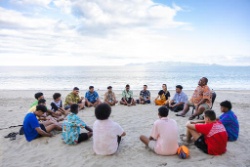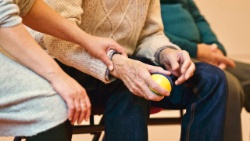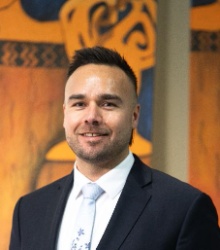Dengue cases in the Pacific are at their highest since 2016, with nearly 19,000 people affected, the World Health Organisation (WHO) says.
The new figures come as multiple nations in the region grapple with outbreaks and surging case numbers.
Just last week, Samoa confirmed a second child with the disease had died this year. Overall, nine dengue-related deaths have been reported across the region.
WHO's Pacific Techincal Support director Dr Mark Jacobs told Pacific Waves that July regional data showed the number of suspected dengue cases was at 18,766 - the highest since 2016.
"We've been seeing a gradual increase in dengue in the Pacific for at least the last couple of decades. But looking at the last 10 years, what we tend to see is peaks in some years and then lower levels in other years.
"This year, so far, we're up to two more than 18,000 suspected cases of dengue….that's the biggest number that we've had certainly in the last 10 years.
Of those, 12,040 were laboratory-confirmed cases.
Jacobs said the high case numbers were due to a range of factors, including the movement of people between Pacific nations.
"The virus that causes dengue fever basically lives in people and lives in mosquitoes. And so for a lot of the…smaller Pacific countries, they haven't got enough people for the virus to keep on circulating all the time.
"What tends to happen in those…Pacific countries is, if there's an outbreak somewhere else in the Pacific, or somewhere where there's people moving to and from, someone might come into that country from another country [where] they've already been infected…and bring the virus back."
Climate change and shifting weather patterns in the region also increased the risk around dengue spread, he said. The lack of understanding around dengue hot-spots was another risk factor.
"It's actually most common in urban settings and semi-urban settings, so towns and villages where there's quite a few people living. [That's where] the mosquito is very comfortable living - in and around people's houses."
A breakdown of the WHO July data, showed spread of the disease had been highest in Fiji, which had 13,702 suspected cases, followed by Tonga (2087) and French Polynesia or Mā'ohi Nui (1079).
The data also showed numbers appeared to have peaked in March. However, in recent months, there had been a resurgence in spread of the virus. In particular, it had been found in previously unaffected nations like American Sāmoa, Nauru and Tuvalu.
Jacobs said the four different strains of dengue also added to challenges around preventing spread and illness. This was because immunity to dengue was generally dependent on individual strains.
"If you've been infected in the past with type one dengue, then you're unlikely to get that sort of dengue again," he said.
"But if…a different strain of the of the dengue virus comes into the country some years later - dengue type two for instance - then all the people who've been infected with type one before, who've been protected against getting type one again, they could all get type two."
Jacobs said that transmission pattern often triggered big outbreaks. It also contributed to more severe illness from dengue.
"If somebody's had dengue more than once, in other words, if they've had it with a couple of the different strains a few years apart, they're the people most likely to get really, really severely ill with dengue.
"And so we see more of the severe dengue, more complications of dengue in those people."
'About 100 confirmed cases per week' in Samoa
In Samoa, the acting director-general of health Tagaloa Dr Robert Thomsen said the government was prioritising mosquito spraying of areas and buildings where people gathered in its response.
These included schools and sites like the Victim Support centre and National University of Sāmoa, he said.
Tangaloa confirmed the recent dengue-related death was an eight-year-old girl. She died on Sunday 13 July. Misiafa Lene, 12, died in April after contracting dengue.
As of 13 July, the number of laboratory-confirmed dengue cases was 1276 in Samoa.
"For the past three weeks - excluding this week - we've seen an increase of about 100 confirmed cases per week," Tagaloa said.
"Our biggest challenge at the moment…is the paediatric age group - children below 15 years of age. [They] appear to be the ones that are mostly affected."



 U.S. Department Of State: The United States Withdraws From The United Nations Educational, Scientific And Cultural Organization (UNESCO)
U.S. Department Of State: The United States Withdraws From The United Nations Educational, Scientific And Cultural Organization (UNESCO) Henley and Partners: Asian Nations Dominate Passport Power Ranking As US And UK Continue To Decline
Henley and Partners: Asian Nations Dominate Passport Power Ranking As US And UK Continue To Decline UNICEF Pacific: 14 Adolescent Representatives From Across The Pacific Call Themselves The Young Pasifika Wayfinders
UNICEF Pacific: 14 Adolescent Representatives From Across The Pacific Call Themselves The Young Pasifika Wayfinders UN News: ‘You Have To Be Able To Rule Your Life’ - The Care Revolution In Latin America
UN News: ‘You Have To Be Able To Rule Your Life’ - The Care Revolution In Latin America NZ Harkness Fellowship Trust: Championing Innovation In Māori Economic Development - Jacob (Hākopa) Ashdown Named 2025 Harkness Fellow
NZ Harkness Fellowship Trust: Championing Innovation In Māori Economic Development - Jacob (Hākopa) Ashdown Named 2025 Harkness Fellow ICHRP: Trump 20% Tariff On Philippine Exports Hits Workers, Farmers Hardest
ICHRP: Trump 20% Tariff On Philippine Exports Hits Workers, Farmers Hardest